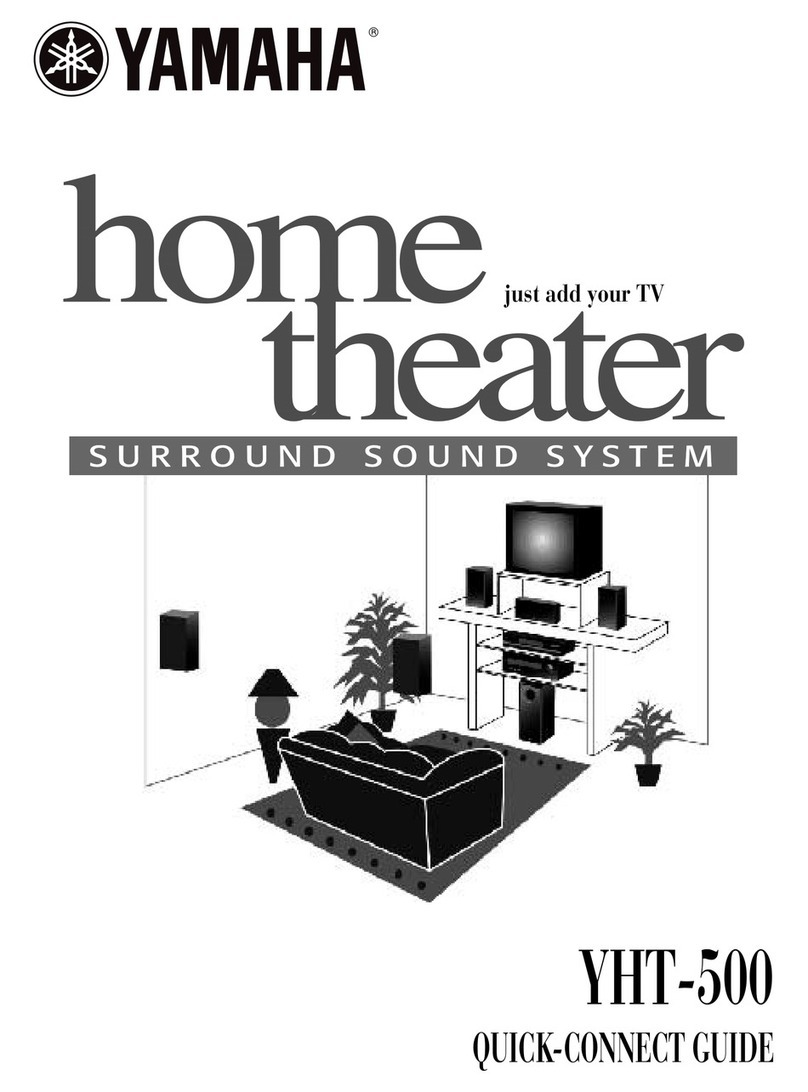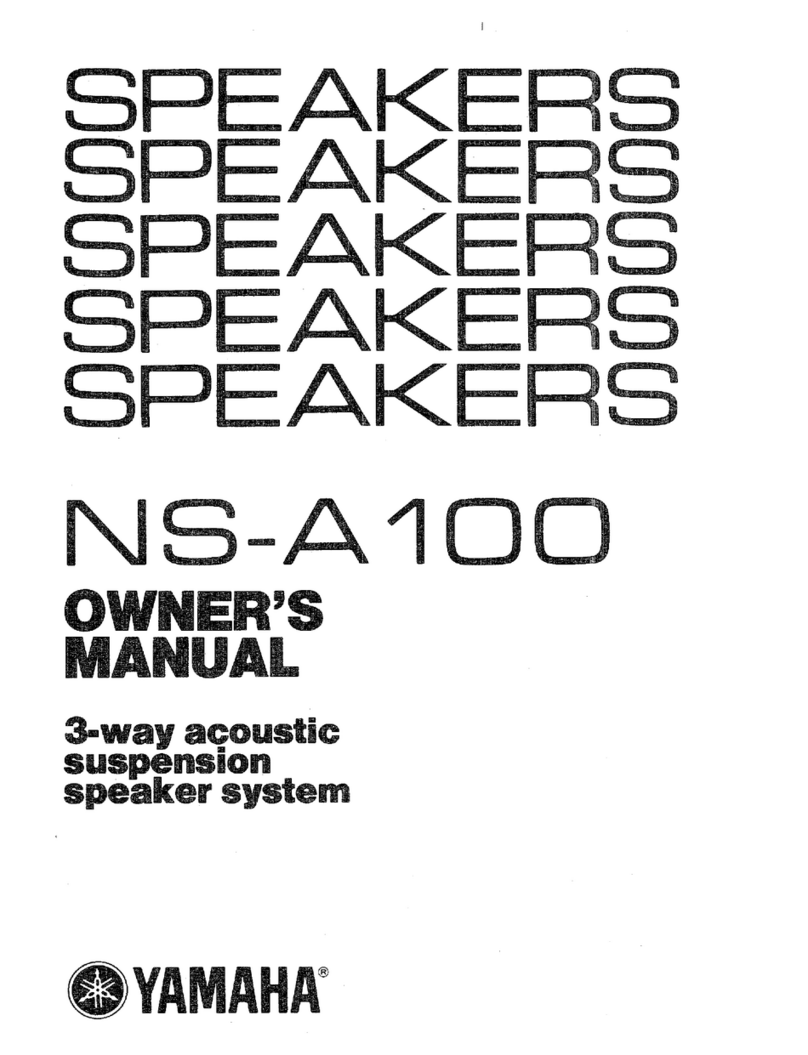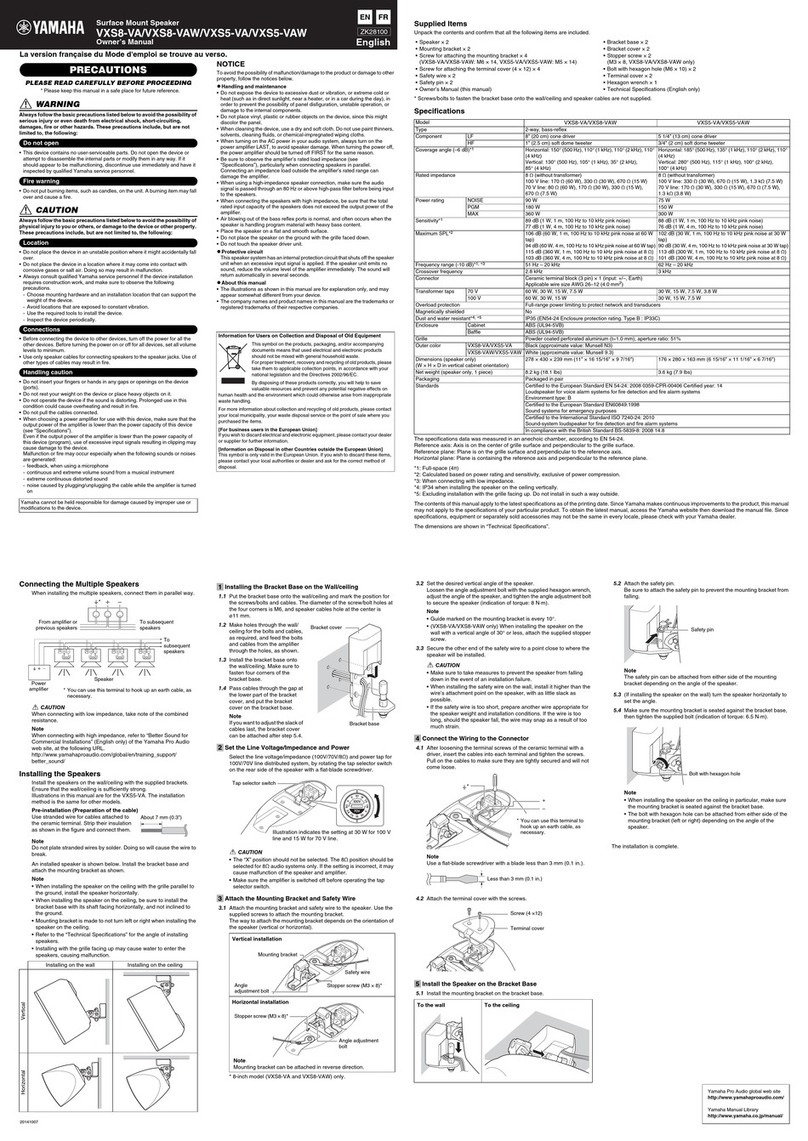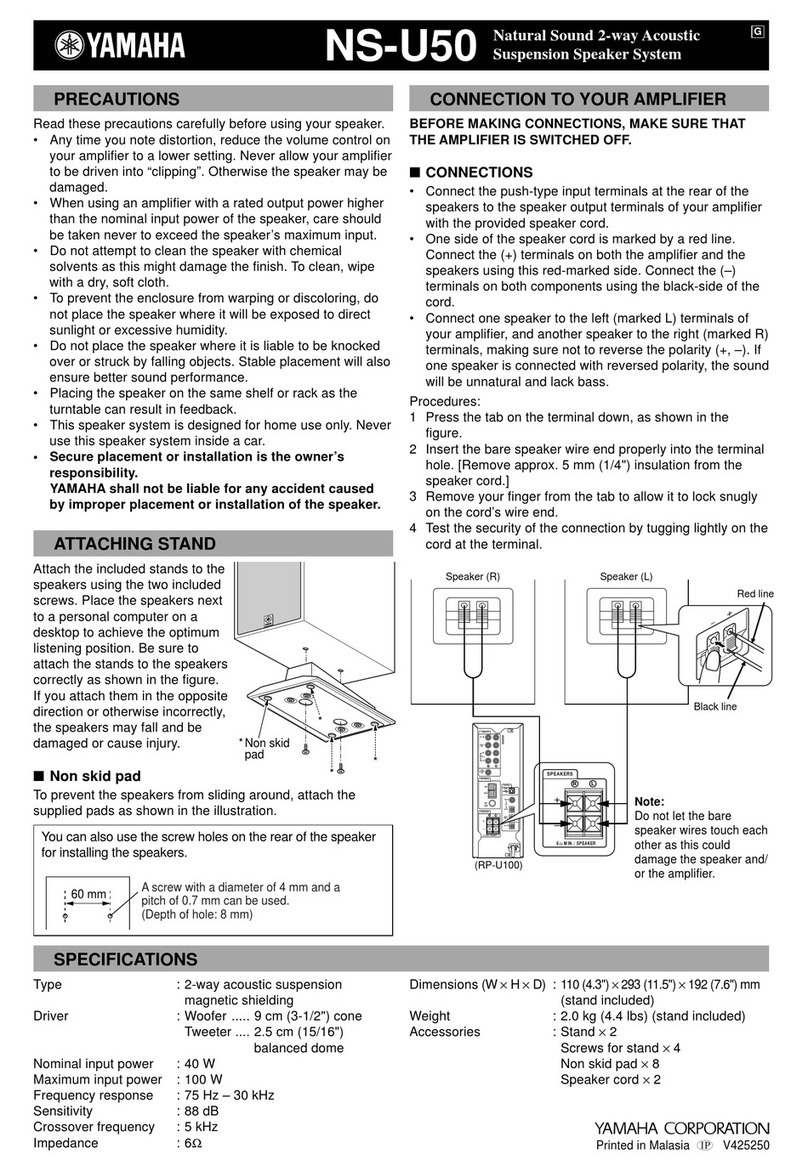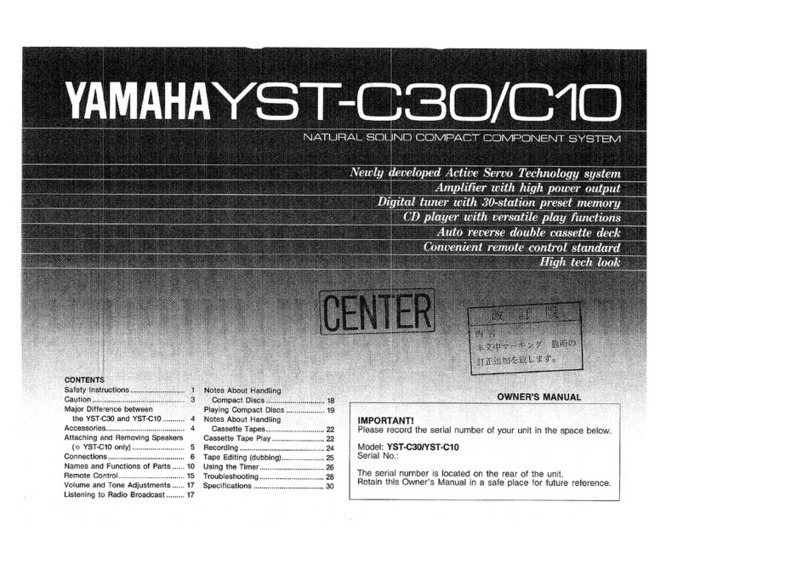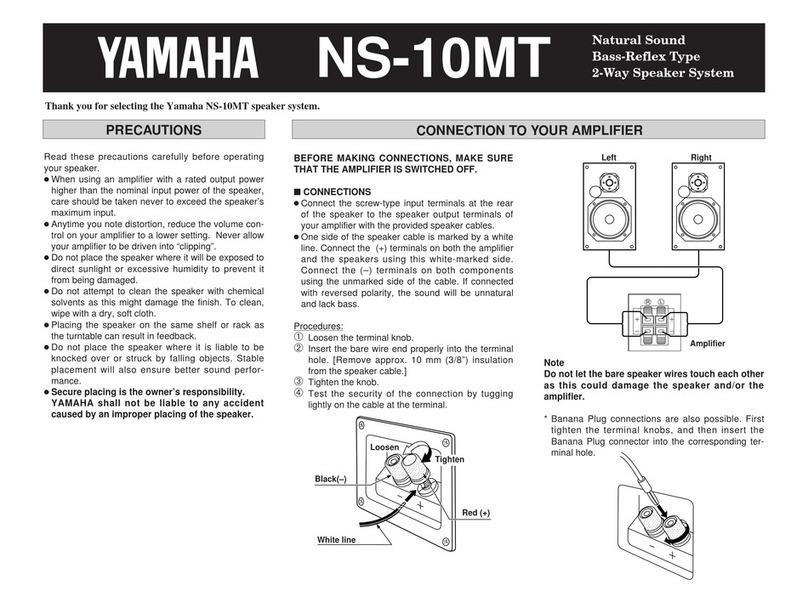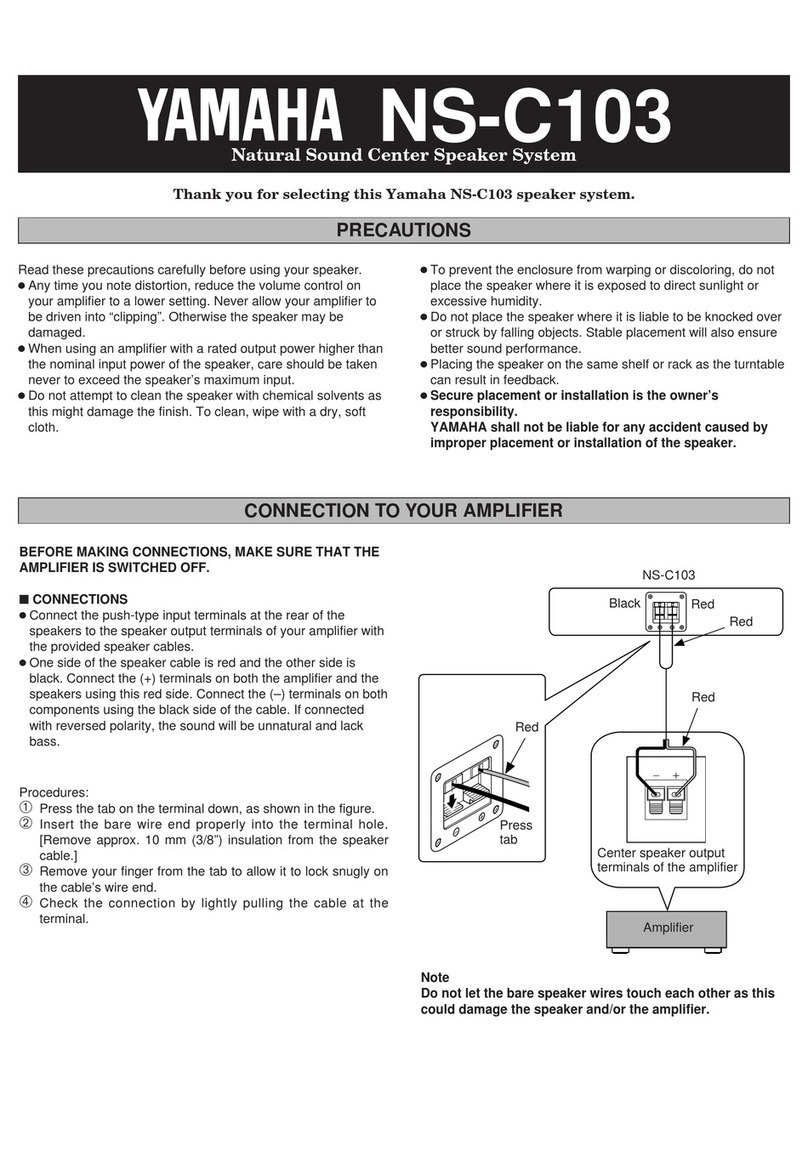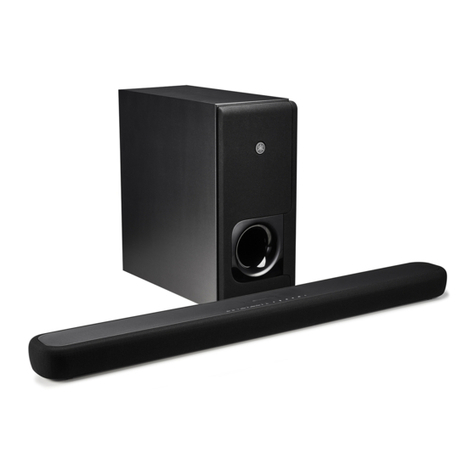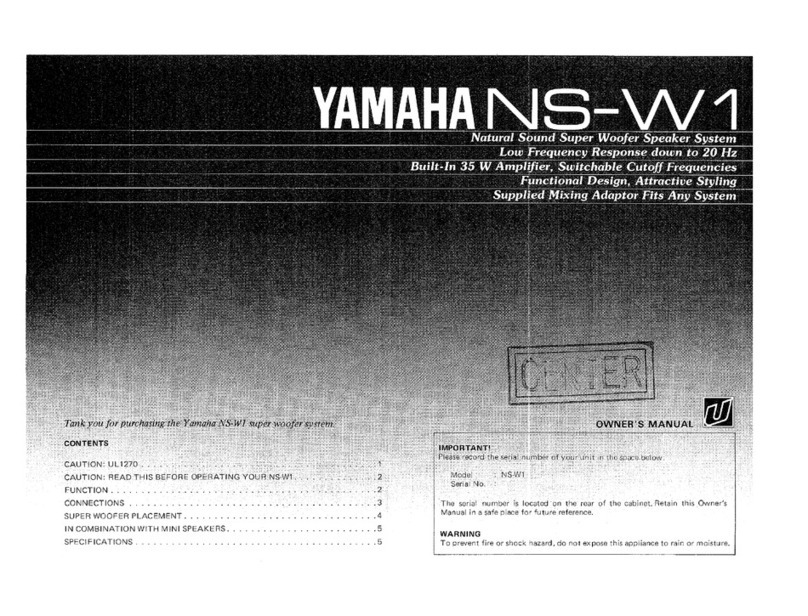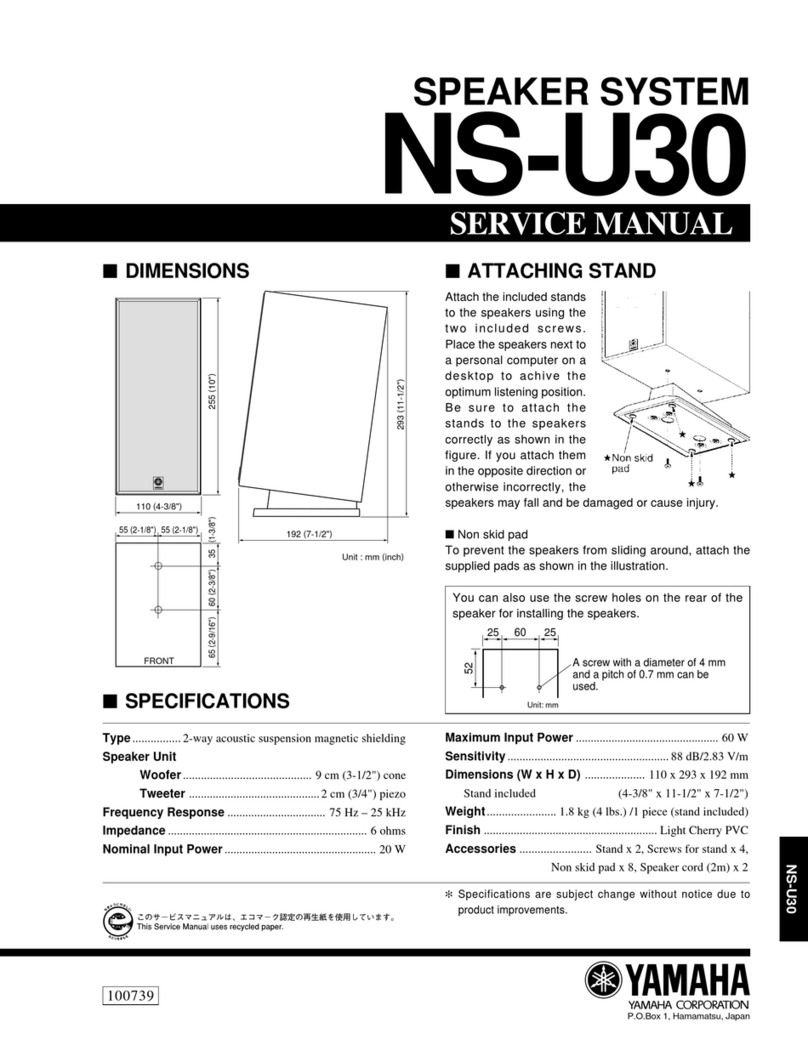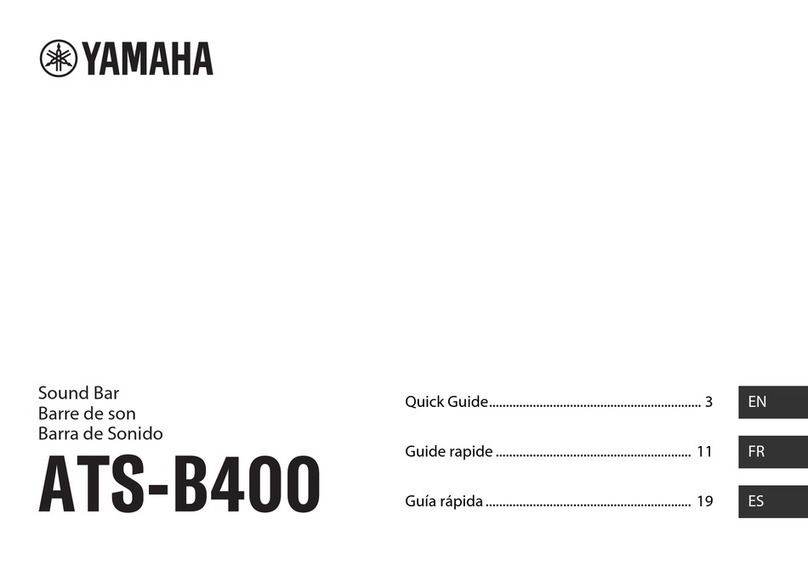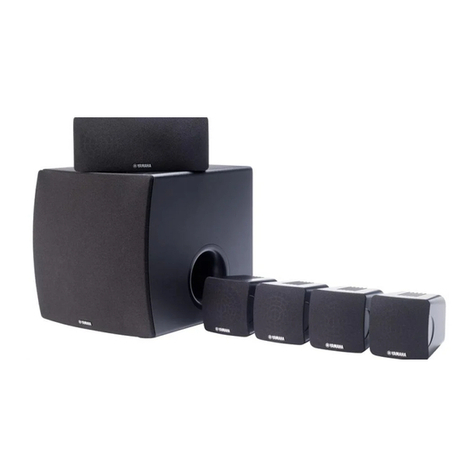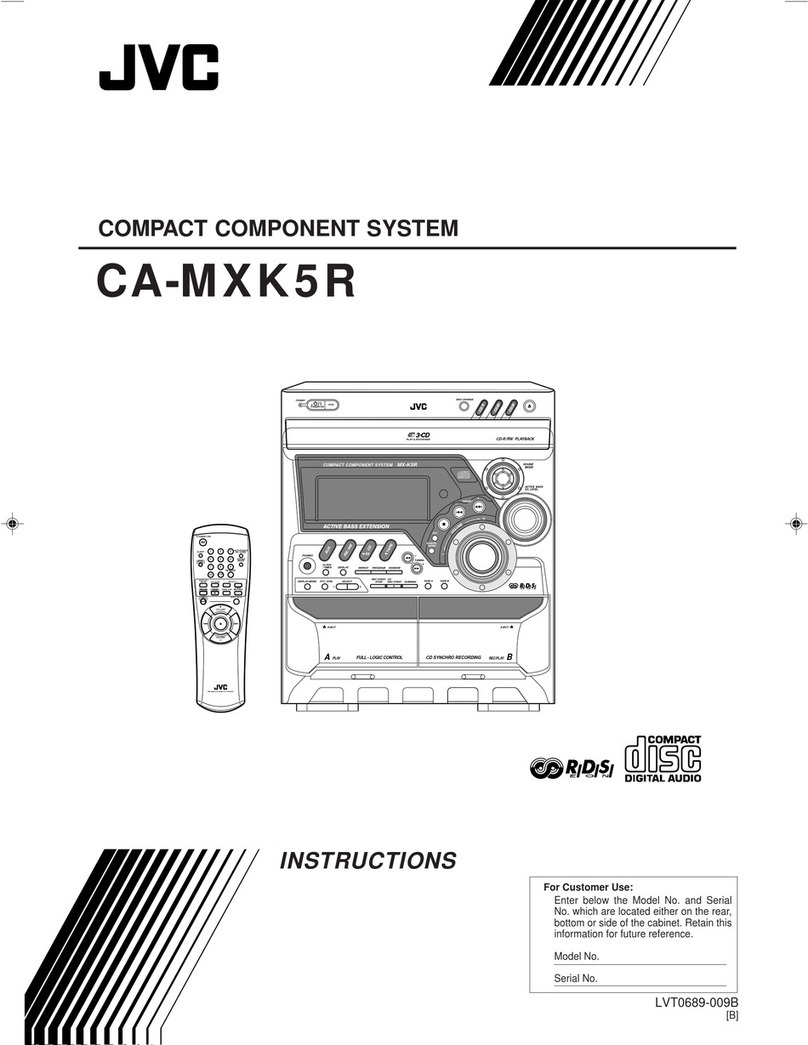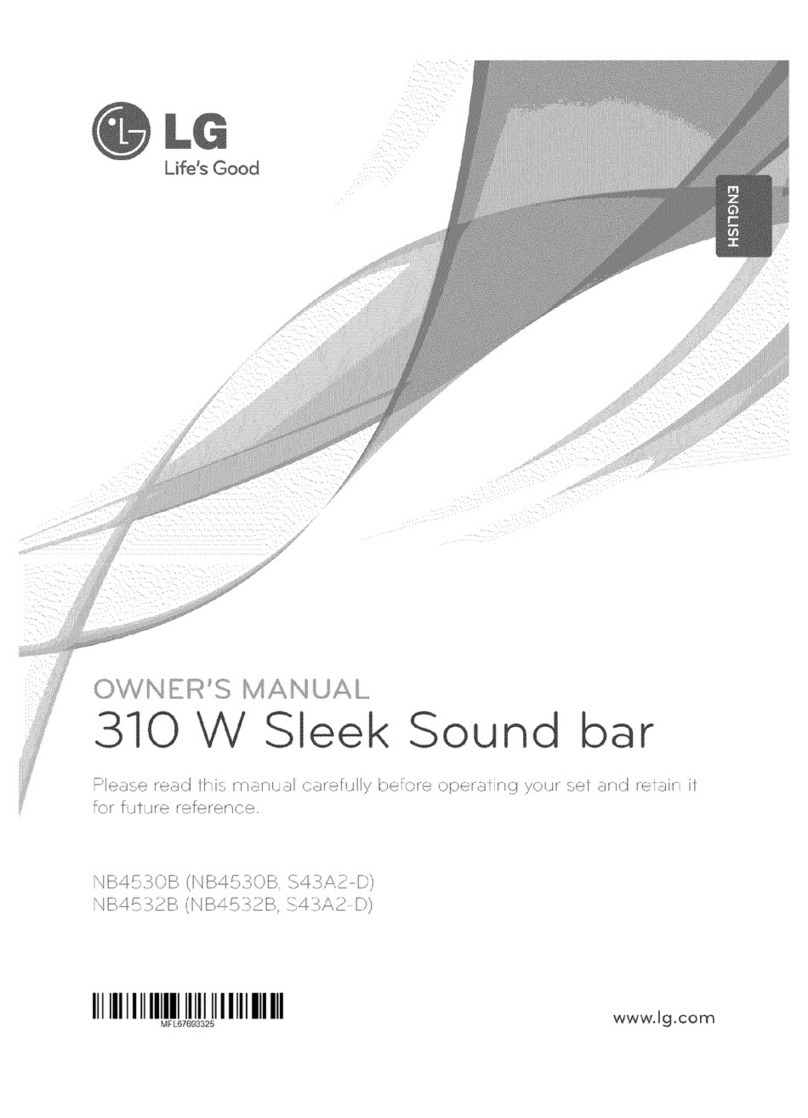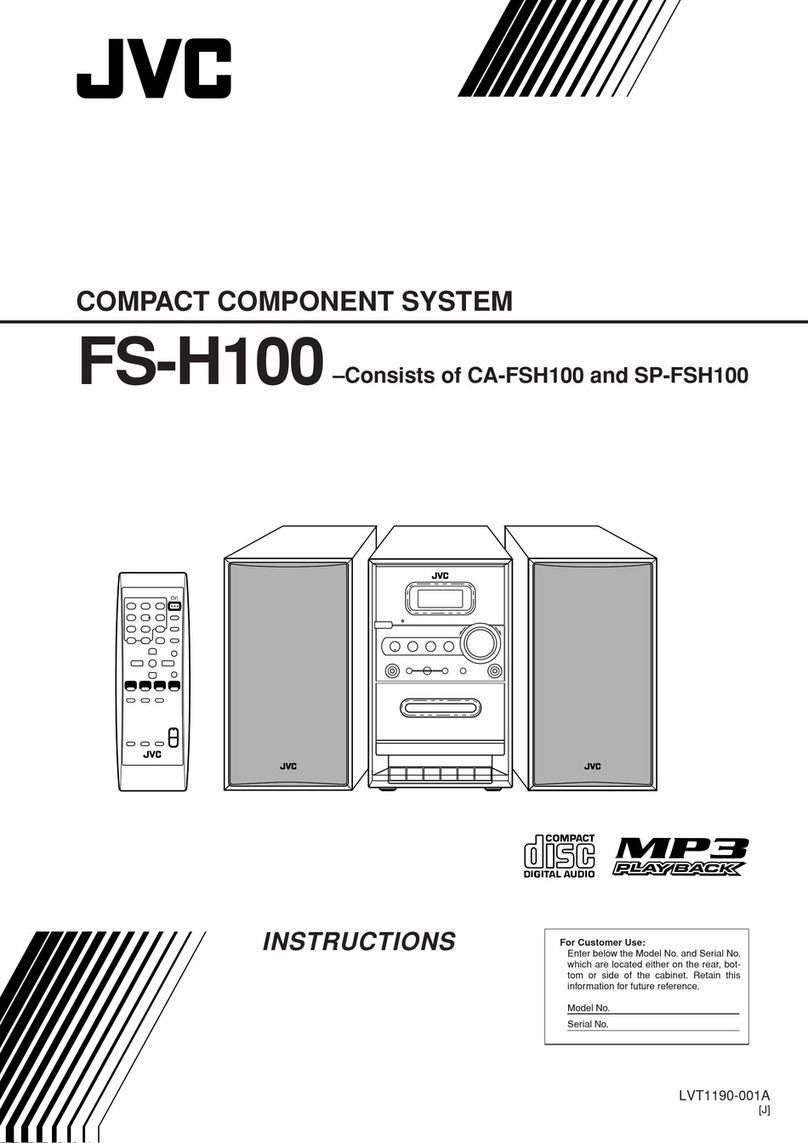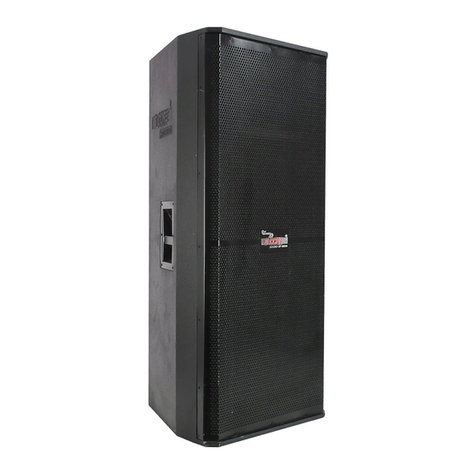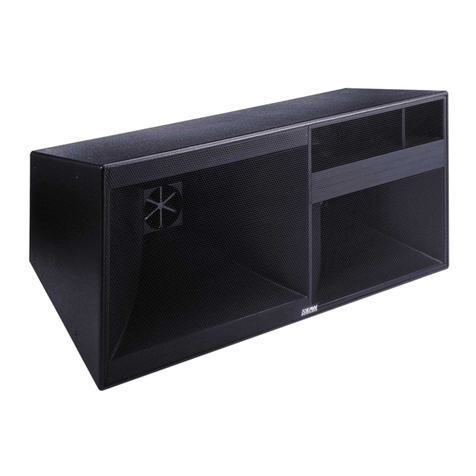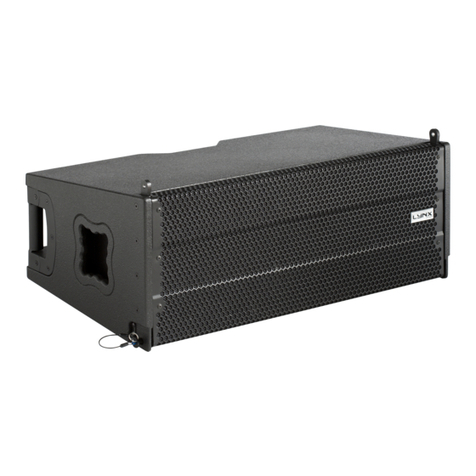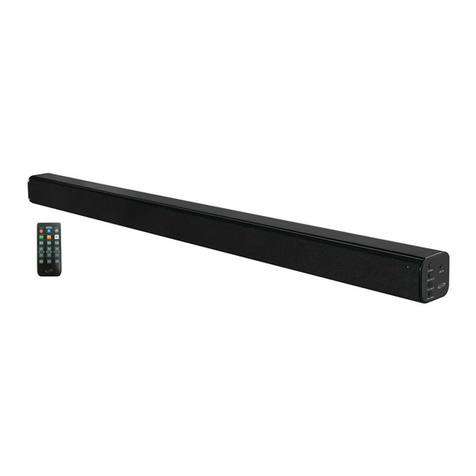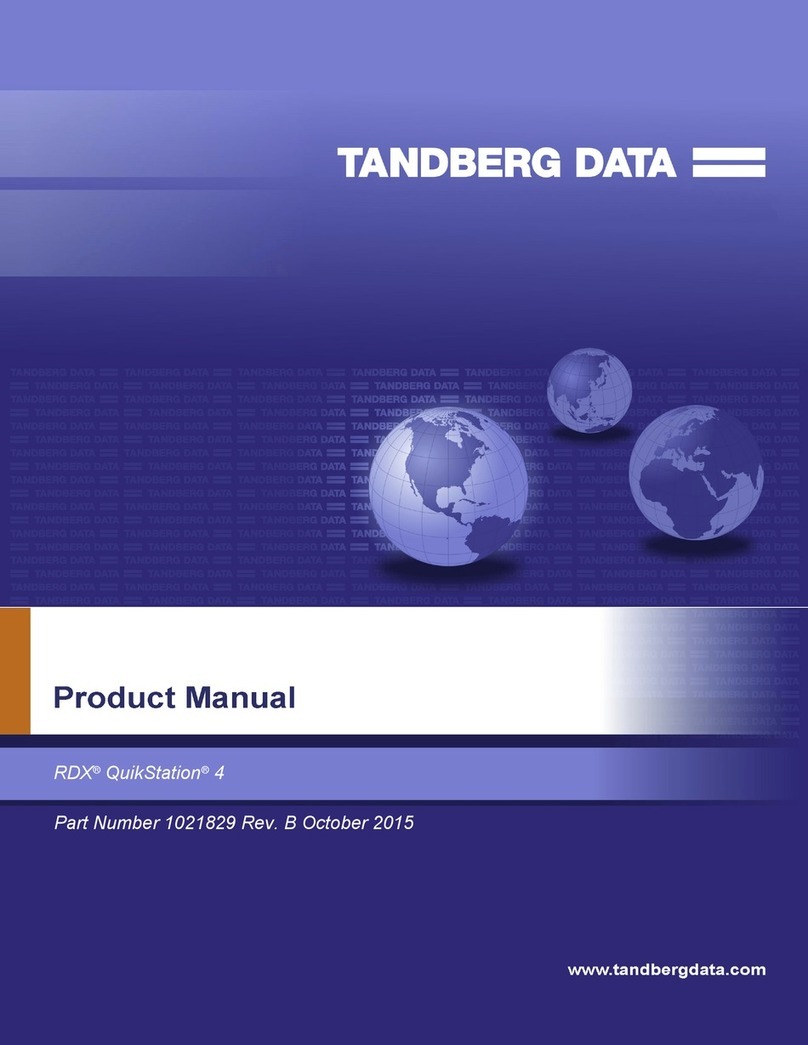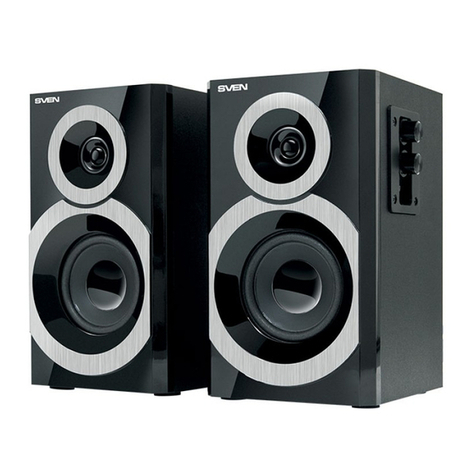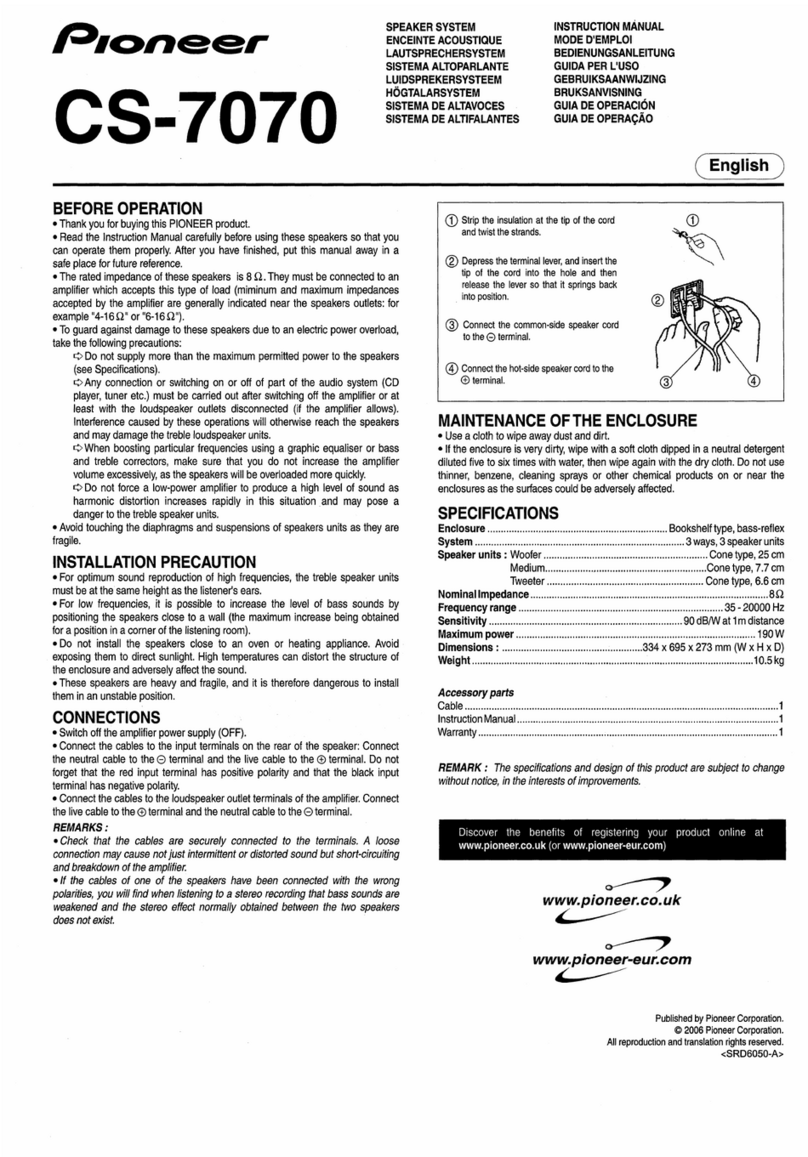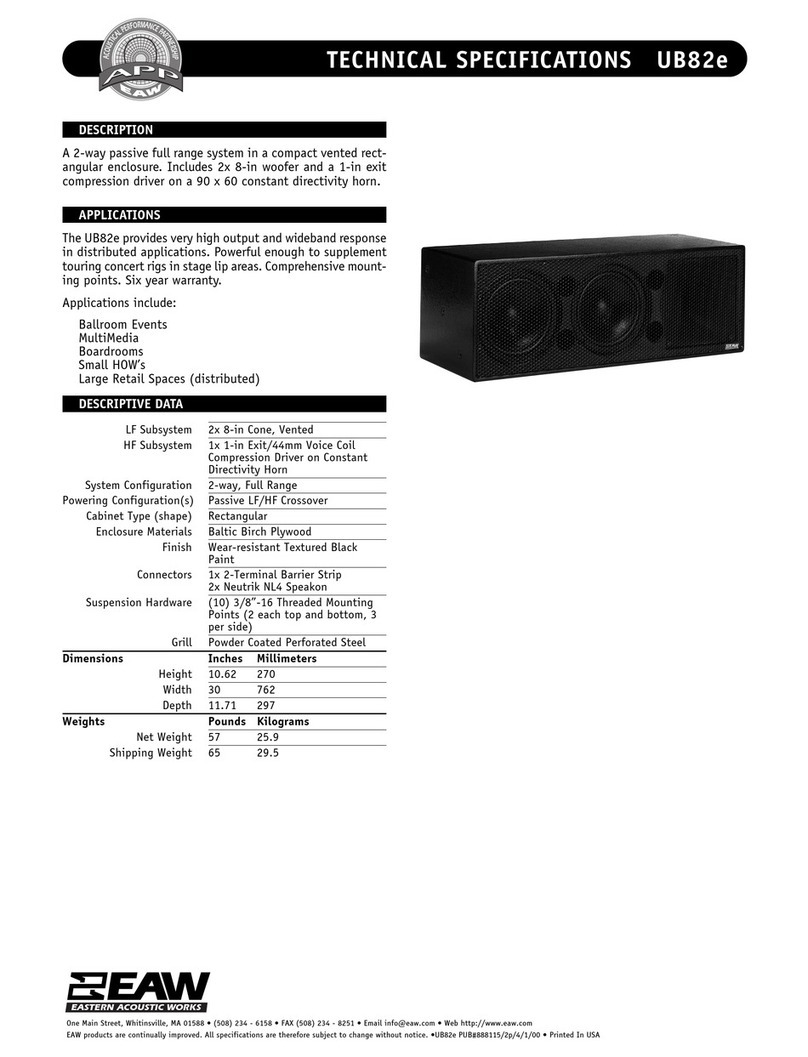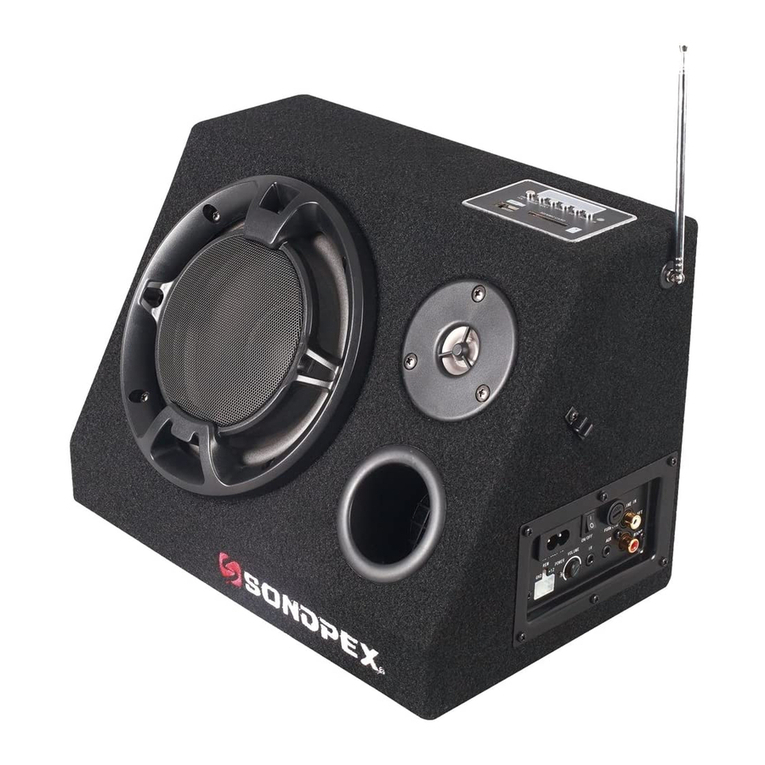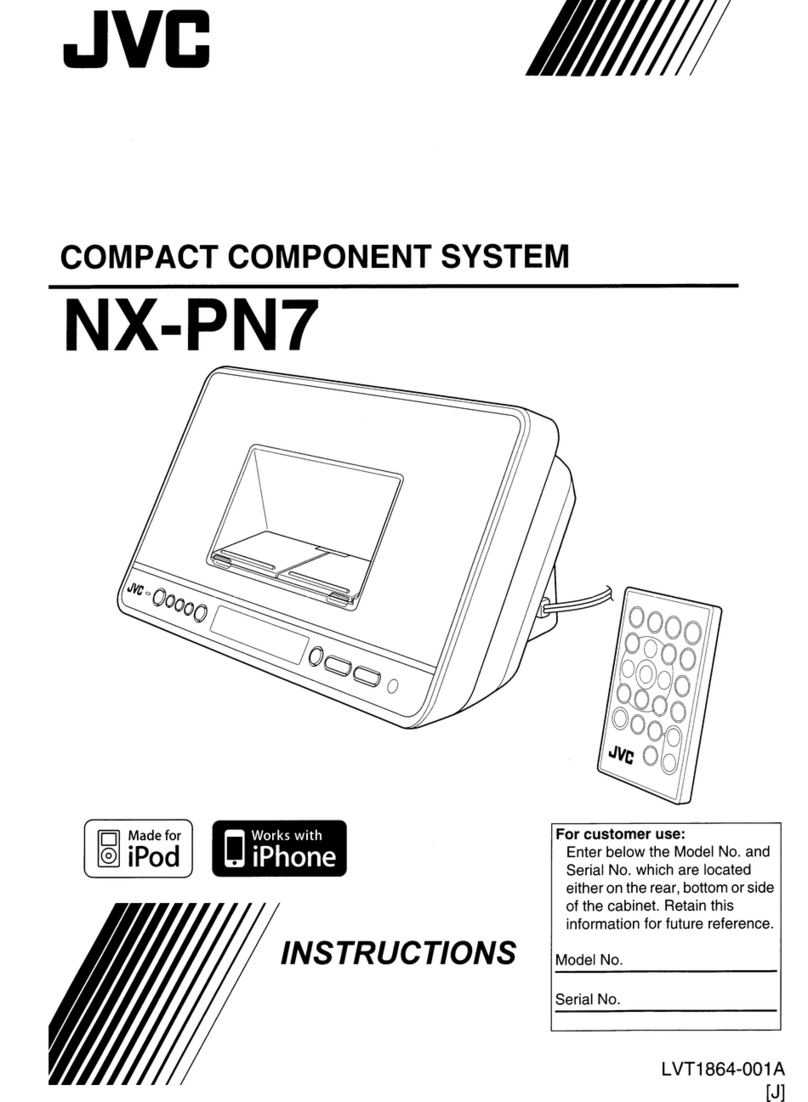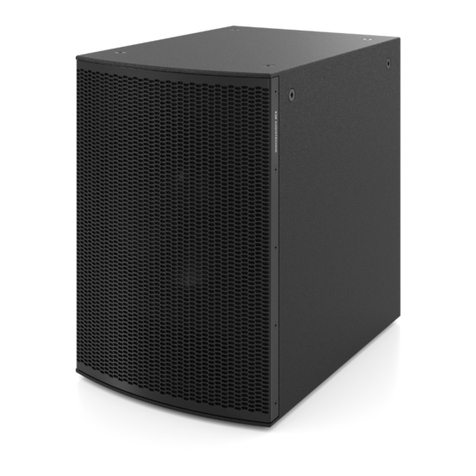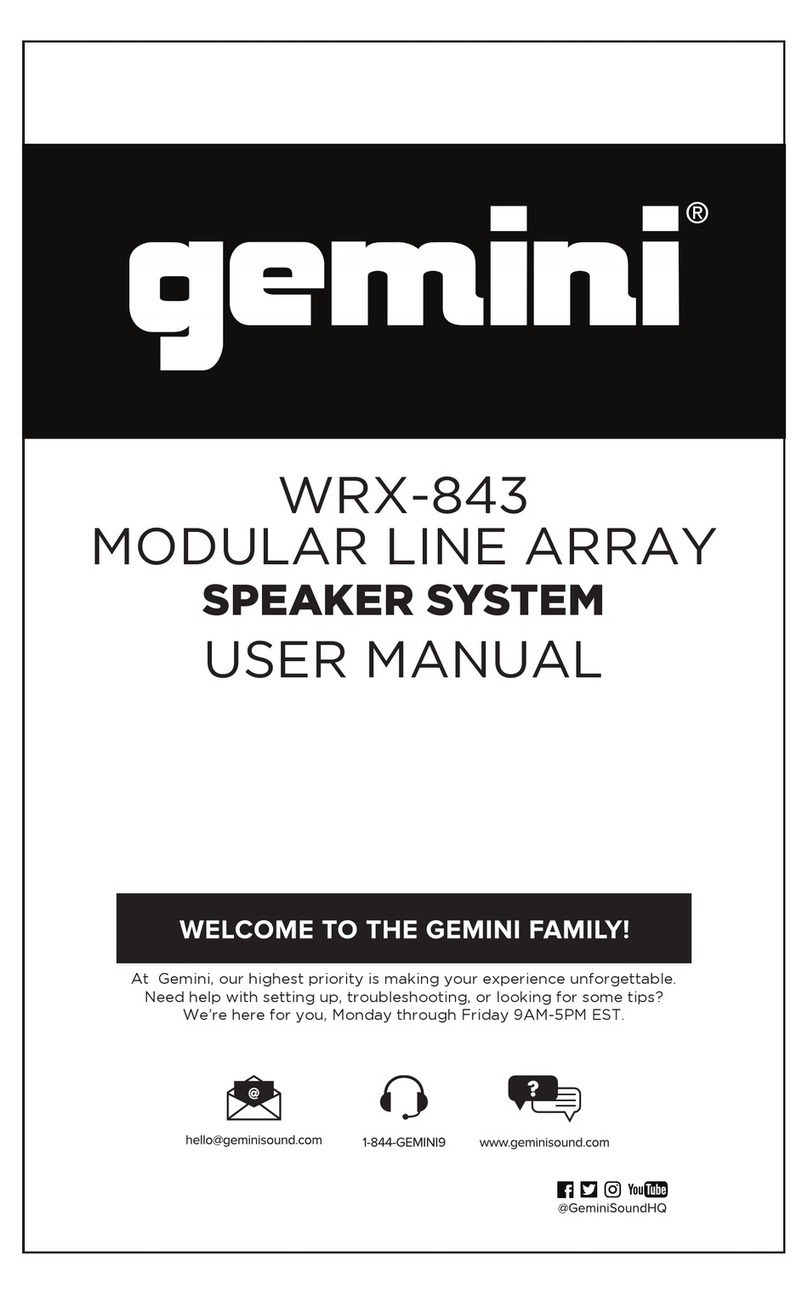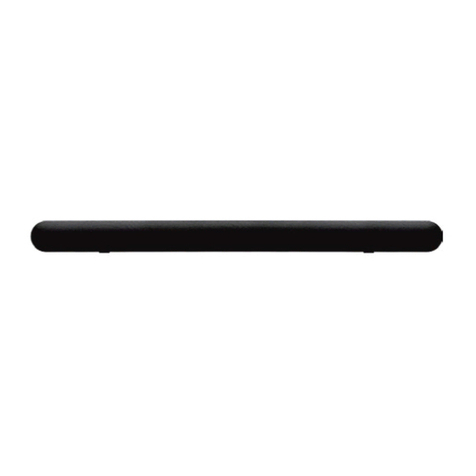
Do not use this unit within 22 cm (9 inches) of persons with a
heart pacemaker implant or debrillator implant.
WARNING
TO REDUCE THE RISK OF FIRE OR ELECTRIC SHOCK,
DO NOT EXPOSE THIS UNIT TO RAIN OR MOISTURE.
As long as this unit is connected to the AC wall outlet, it is not
disconnected from the AC power source even if you turn off
this unit by . In this state, this unit is designed to consume a
very small quantity of power.
(Power key)
Turns on the power of this unit or sets it to the standby mode.
FOR YAS-CU201
• To assure the nest performance, please read this manual
carefully. Keep it in a safe place for future reference.
• Install this unit in a well ventilated, cool, dry, clean place
- away from direct sunlight, heat sources, vibration, dust,
moisture, and/or cold. For proper ventilation, allow the
following minimum clearances.
Top: 5 cm (2 in), Rear: 5 cm (2 in), Sides: 1 cm (3/8 in)
• Locate this unit away from other electrical appliances, motors,
or transformers to avoid humming sounds.
• Do not expose this unit to sudden temperature changes from
cold to hot, and do not locate this unit in an environment
with high humidity (i.e. a room with a humidier) to prevent
condensation inside this unit, which may cause an electrical
shock, re, damage to this unit, and/or personal injury.
• Avoid installing this unit where foreign objects may fall onto
this unit and/or this unit may be exposed to liquid dripping or
splashing. On the top of this unit, do not place:
– Other components, as they may cause damage and/or
discoloration on the surface of this unit.
– Burning objects (i.e. candles), as they may cause re,
damage to this unit, and/or personal injury.
– Containers with liquid in them, as they may fall and liquid
may cause electrical shock to the user and/or damage to this
unit.
• Do not cover this unit with a newspaper, tablecloth, curtain,
etc. in order not to obstruct heat radiation. If the temperature
inside this unit rises, it may cause re, damage to this unit,
and/or personal injury.
• Do not plug in this unit to a wall outlet until all connections
are complete.
• Do not operate this unit upside-down. It may overheat,
possibly causing damage.
• Do not use force on switches, knobs and/or cords.
• When disconnecting the power cable from the wall outlet,
grasp the plug; do not pull the cable.
• Do not clean this unit with chemical solvents; this might
damage the nish. Use a clean, dry cloth.
• Only voltage specied on this unit must be used. Using this
unit with a higher voltage than specied is dangerous and may
cause re, damage to this unit, and/or personal injury. Yamaha
will not be held responsible for any damage resulting from use
of this unit with a voltage other than specied.
• To prevent damage by lightning, keep the power cable and
outdoor antennas disconnected from a wall outlet or the unit
during a lightning storm.
• Do not attempt to modify or x this unit. Contact qualied
Yamaha service personnel when any service is needed. The
cabinet should never be opened for any reasons.
• When not planning to use this unit for long periods of time (i.e.
vacation), disconnect the AC power plug from the wall outlet.
• Be sure to read the “Troubleshooting” section on common
operating errors before concluding that this unit is faulty.
• Before moving this unit, press to set this unit in standby
mode, and disconnect the power supply cable from the wall
outlet.
• Condensation will form when the surrounding temperature
changes suddenly. Disconnect the power supply cable from the
outlet, then leave the unit alone.
• Install this unit near the wall outlet and where the AC power
plug can be reached easily.
• The batteries shall not be exposed to excessive heat such as
sunshine, re or like.
• Secure placement or installation is the owner’s responsibility.
Yamaha shall not be liable for any accident caused by
improper placement or installation of speakers.
FOR NS-WSW40
• To assure the nest performance, please read this manual
carefully. Keep it in a safe place for future reference.
• Install this unit in a cool, dry, clean place - away from
windows, heat sources, sources of excessive vibration, dust,
moisture and cold. Avoid sources of humming (transformers,
motors). To prevent re or electrical shock, do not expose this
unit to rain or water.
• The voltage to be used must be the same as that specied
on the rear panel. Using this unit with a higher voltage than
specied is dangerous and may cause a re and/or electric
shock.
• Do not use force on switches, controls or connection wires.
When moving the unit, rst disconnect the power plug and
the wires connected to other equipment. Never pull the wires
themselves.
• When not planning to use this unit for a long period (ie.,
vacation, etc.), disconnect the AC power plug from the wall
outlet.
• To prevent lightning damage, disconnect the AC power plug
when there is an electric storm.
• Since this unit has a built-in power amplier, heat will radiate
from the rear panel. Place the unit apart from the walls,
allowing at least 20 cm of space above, behind and on both
sides of the unit to prevent re or damage.
Furthermore, do not position with the rear panel facing down
on the oor or other surfaces.
• Do not cover the rear panel of this unit with a newspaper,
a tablecloth, a curtain, etc., in order not to obstruct heat
radiation. If the temperature inside the unit rises, it may cause
re, damage to the unit and/or personal injury.
• Do not place the following objects on this unit:
– Glass, china, small metallic, etc.
If glass, etc., falls as a result of vibrations and breaks, it may
cause bodily injury.
– A burning candle etc.
If the candle falls as a result of vibration, it may cause re
and bodily injury.
– A vessel containing water
If the vessel falls as a result of vibration and water spills,
it may cause damage to the speaker, and/or you may get an
electric shock.
• Do not place this unit where foreign material, such as dripping
water. It might cause re, damage to this unit, and/or personal
injury.
• Never put a hand or a foreign object into the YST port located
on the right side of this unit. When moving this unit, do not
hold the port, as it might cause personal injury and/or damage
to this unit.
• Never place a fragile object near the YST port of this unit. If
the object falls or drops as a result of the air pressure, it may
cause damage to the unit and/or personal injury.
• Never open the cabinet. It might cause an electric shock, since
this unit uses a high voltage. It might also cause personal
injury and/or damage to this unit. If something drops into the
set, contact your dealer.
• When using a humidier, be sure to avoid condensation inside
this unit by allowing enough space around this unit or avoiding
excess humidication. Condensation might cause re, damage
to this unit, and/or electric shock.
• Super-bass frequencies reproduced by this unit may cause a
turntable to generate a howling sound. In such a case, move
this unit away from the turntable.
• This unit may be damaged if certain sounds are continuously
output at high volume level. For example, if 20 Hz-50 Hz
sine waves from a test disc, bass sounds from electronic
instruments, etc., are continuously output, or when the stylus
of a turntable touches the surface of a disc, reduce the volume
level to prevent this unit from being damaged.
• If you hear distortion (i.e., unnatural, intermittent “rapping”
or “hammering” sounds) coming from this unit, reduce the
volume level. Extremely loud playing of a movie soundtrack’s
low frequency, bass-heavy sounds or similarly loud popular
music passages can damage this speaker system.
• Vibration generated by super-bass frequencies may distort
images on a TV. In such a case, move this unit away from the
TV set.
• Do not attempt to clean this unit with chemical solvents as this
might damage the nish. Use a clean, dry cloth.
• Be sure to read the “TROUBLESHOOTING” section
regarding common operating errors before concluding that the
unit is faulty.
• Install this unit near the wall outlet and where the AC power
plug can be reached easily.
Notes on remote controls and batteries
• Do not spill water or other liquids on the remote control.
• Do not drop the remote control.
• Do not leave or store the remote control in the following
places:
– places of high humidity, such as near a bath
– places of high temperatures, such as near a heater or a stove
– places of extremely low temperatures
– dusty places
• Do not expose the remote control sensor of this unit to direct
sunlight or lighting such as inverted uorescent lamps.
• If the batteries grow old, the effective operation range of the
remote control decreases considerably. If this happens, replace
the batteries with two new ones as soon as possible.
• Do not use old batteries together with new ones.
• Do not use different types of batteries (such as alkaline and
manganese batteries) together. Read the packaging carefully as
these different types of batteries may have the same shape and
color.
• Exhausted batteries may leak. If the batteries have leaked,
dispose of them immediately. Avoid touching the leaked
material or letting it come into contact with clothing, etc.
Clean the battery compartment thoroughly before installing
new batteries.
• Do not throw away batteries with general house waste.
Dispose of them correctly in accordance with your local
regulations.
• Keep batteries away from children. If a battery is accidentally
swallowed, contact your doctor immediately.
• When not planning to use the remote control for long periods
of time, remove the batteries from the remote control.
• Do not charge or disassemble the supplied batteries.
Radio waves may affect electro-medical devices.
Do not use this unit near medical devices or inside medical
facilities.
Yamaha Music (Asia) Private Limited
Blk 202 Hougang St 21 #02-00, Singapore 530202
Tel: 65-6747-4374
Yamaha Music (Malaysia) Sdn. Bhd.
No.8 Jalan Perbandaran, Kelana Jaya, 47301 Petaling Jaya,
Selangor, Malaysia
Tel: 60-3-7803-0900
P.T. Yamaha Musik Indonesia (Distributor)
Yamaha Music Center Bldg., Jl. Jend. Gatoto Subroto Kav. 4,
Jakarta 12930, Indonesia
Tel: 62-21-520-2579
Yamaha Music India Pvt. Ltd.
Spazedge Building, Ground Floor, Tower-A, Sector-47,
Gurgaon-Sohna Road, Gurgaon -122002, Haryana, India
Tel: 91-124-4853300
Siam Music Yamaha Co., Ltd.
Siam Motors Building, 891/1 Rama 1 Rd., Wangmai,
Pathumwan, Bangkok, 10330 Thailand
Tel: 66-2-215-2626-39
Yamaha de México, S.A. de C.V.
Eje 5 Ote. Javier Rojo Gomez 1149, Iztapalapa, D.F., México
Tel: 52-55-5804-0600
Yamaha Music Latin America, S.A.
Torre Banco General Piso 7, Marbella Calle 47 y Aquilino de
la Guardia, Ciudad de Panamá, Panamá
Tel: 507-269-5311
CAUTION: READ THIS BEFORE OPERATING YOUR UNIT.
iEn
English
